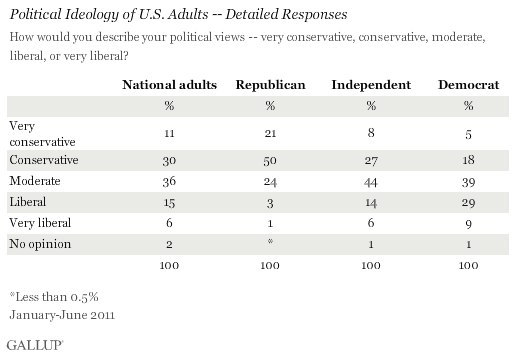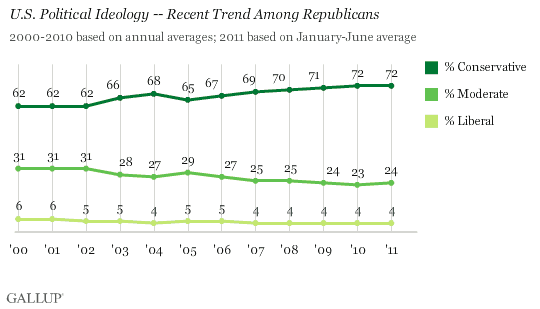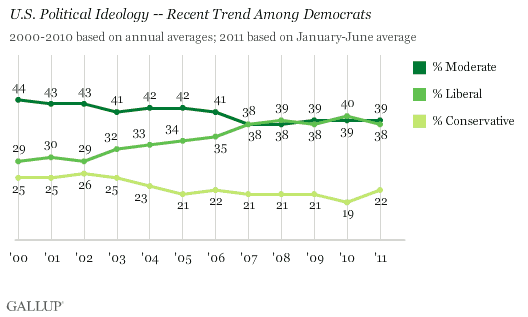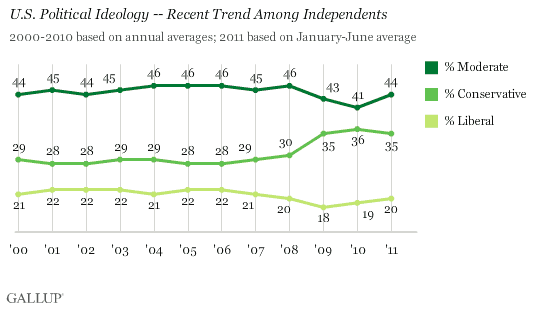PRINCETON, NJ -- Americans' political ideology at the midyear point of 2011 looks similar to 2009 and 2010, with 41% self-identifying as conservative, 36% as moderate, and 21% as liberal.

If this pattern continues, 2011 will be the third straight year that conservatives significantly outnumber moderates -- the next largest ideological bloc. Liberalism has been holding steady for the past six years, averaging either 21% or 22%, although notably higher than the 17% average seen in Gallup polling during the early to middle '90s.
Longer term, the Gallup ideology trend, dating from 1992, documents increased political polarization in the country. The percentage of moderates has fallen to the mid-30s from the low 40s, while the combined percentage either liberal or conservative is now 62%, up from 53%.
The 2011 half-year results are based on more than 10,000 U.S. national adults interviewed across 10 Gallup and USA Today/Gallup surveys conducted from January through June.
Hard Right Republicans Outnumber Hard Left Democrats
A much higher proportion of Republicans call themselves "very conservative" or "conservative" (71%) than Democrats call themselves "very liberal" or "liberal" (38%). Democrats are as likely to call themselves moderates as liberals.
Additionally conservative Republicans are a bit more likely to call themselves very conservative than liberal Democrats are to identify as very liberal. As a result, hard right Republicans outnumber hard left Democrats by more than 2 to 1, 21% vs. 9%.
Relatively small and equally matched proportions of independents put themselves at the far right and far left of the political spectrum. The plurality of independents (44%) says they are moderate.

No Apparent Change in Partisans' Ideological Leanings
Gallup has previously described an increasing polarization of Republicans and Democrats, ideologically, with Republicans becoming more conservative and Democrats more liberal. Thus far in 2011, the ideological outlook of both groups, as well as of independents, is similar to what it was in 2010.
Among Republicans, conservatives currently outnumber moderates by nearly 3 to 1, 72% vs. 24%, while very few are liberal (4%).

Democrats' ideological profile is similar to what it has been since 2007, following a gradual increase in those calling themselves liberal and decreases in those identifying themselves as moderates and conservatives. Currently, about 4 in 10 Democrats are liberal, another 4 in 10 are moderate, and about 2 in 10 are conservative.

By 44% to 35%, more independents are moderate than conservative -- with the percentage conservative continuing to be a notch higher than it was from 2000 to 2008. Another 20% are liberal, similar to the national average. Conservatism among independents increased fairly sharply in 2009, from 30% to 35%, largely explaining the expansion of conservatism nationally at that time, and it has held at that level since then.

Bottom Line
The U.S. political culture is a broad mix of conservatives, moderates, and liberals, with conservatives continuing to be the largest group by a slight, but statistically significant, margin over moderates. This pattern first emerged in 2009, driven by increased conservatism among independents, and has since persisted. Partly as a result, the country is more polarized today than it was in 1992.
All three ideology groups coexist under a divided federal government that has struggled to reach agreement on how to raise the nation's debt ceiling. The source of congressional leaders' difficulty unifying their own members on the matter is evident in the finding that even within the parties there exists a mix of moderates and liberals (in the case of Democrats) and strong conservatives and not-so-strong conservatives (in the case of Republicans) tugging their respective parties in different directions.
Survey Methods
Results are based on the combined data for 10 separate USA Today/Gallup polls conducted from January through June 2011.
For results based on the total sample of 10,265 national adults, one can say with 95% confidence that the maximum margin of sampling error is ±1 percentage point.
Party breakdowns for this 2011 midyear report are based on 3,094 Republicans, 3,940 independents, and 3,054 Democrats. For results based on samples of these sizes, one can say with 95% confidence that the maximum margin of sampling error is ±2 percentage points.
Interviews are conducted with respondents on landline telephones and cellular phones, with interviews conducted in Spanish for respondents who are primarily Spanish-speaking. Each sample includes a minimum quota of 400 cell phone respondents and 600 landline respondents per 1,000 national adults, with additional minimum quotas among landline respondents for gender within region. Landline telephone numbers are chosen at random among listed telephone numbers. Cell phone numbers are selected using random-digit-dial methods. Landline respondents are chosen at random within each household on the basis of which member had the most recent birthday.
Samples are weighted by gender, age, race, Hispanic ethnicity, education, region, adults in the household, and phone status (cell phone only/landline only/both, cell phone mostly, and having an unlisted landline number). Demographic weighting targets are based on the March 2010 Current Population Survey figures for the aged 18 and older non-institutionalized population living in U.S. telephone households. All reported margins of sampling error include the computed design effects for weighting and sample design.
In addition to sampling error, question wording and practical difficulties in conducting surveys can introduce error or bias into the findings of public opinion polls.
For more details on Gallup's polling methodology, visit https://www.gallup.com/.
